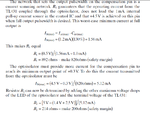--BawA--
Advanced Member level 1
- Joined
- Nov 28, 2012
- Messages
- 479
- Helped
- 43
- Reputation
- 86
- Reaction score
- 42
- Trophy points
- 1,318
- Location
- Noida, INDIA
- Activity points
- 4,926
Hi everyone,
i am trying to eshtablish an isolated feedback loop for my forward converter, currently i am referring to "POWER SUPPLY COOKBOOK BY MARTY BROWN"

i am also attaching an image ,in which the dimensioning of the resistors are carried out,

the controller ic is UC3843
, now can someone explain me why why Icc max is 1.2ma?
and how did they calculate the value of R1?
i am trying to eshtablish an isolated feedback loop for my forward converter, currently i am referring to "POWER SUPPLY COOKBOOK BY MARTY BROWN"

i am also attaching an image ,in which the dimensioning of the resistors are carried out,

the controller ic is UC3843
, now can someone explain me why why Icc max is 1.2ma?
and how did they calculate the value of R1?
